#forty-seven ronin
Explore tagged Tumblr posts
Photo
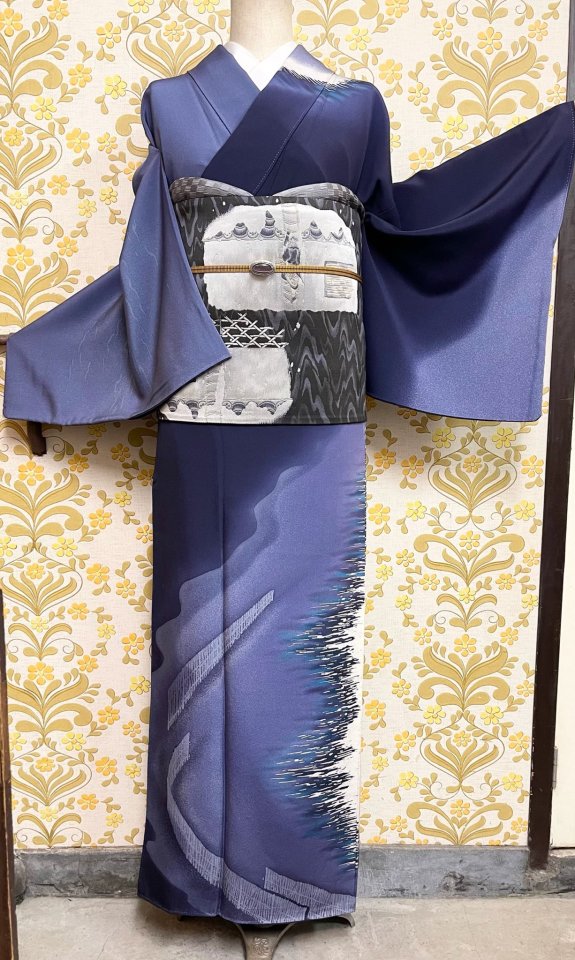
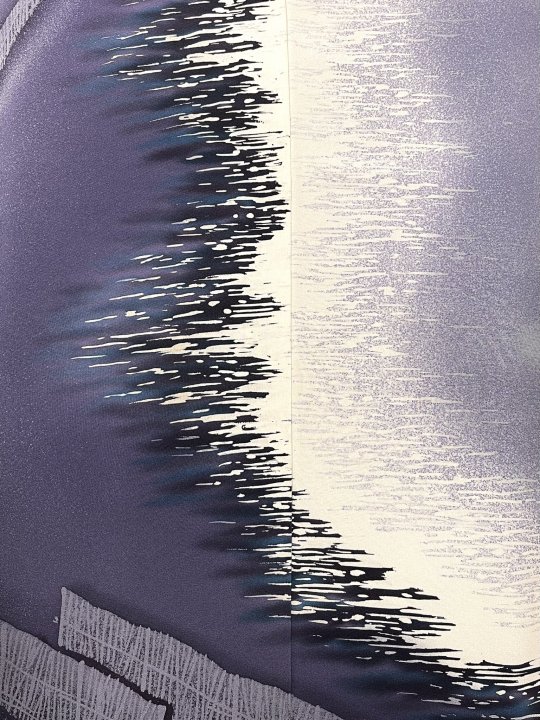


Refined colors for this muted outfit, pairing a soothing kimono depicting a beach and moonlit sea, paired with an unusual obi with people scaling walls on bamboo ladders.
The obi is a nod to an episode of the famous Forty-seven ronin narrative, where the loyal ronin after months of careful planning, attack the mansion of their ennemy Kira Yoshinaka (Moronao in Chushingura plays) to assassinate him in the dead of night.
#japan#fashion#kimono#obi#sea#moonlit sea#47 ronin#Forty-seven ronin#akoroshi#赤穂浪士#Shijūshichishi#四十七士#Chūshingura#忠臣蔵#The Treasury of Loyal Retainers#samurai#ronin#着物#帯
157 notes
·
View notes
Text
Sasuke and Japanese Masculinity
There are some Naruto/Sasuke blogs that I generally like and I am in agreement with many of their analysis but one of the ideas perpetuated by them is the idea that Sasuke is the feminine counterpart to Naruto' s masculine one or that he has characteristics typical of a heroine, which I can not agree with.
Let's start with one of the most befuddling claims that I have come across -
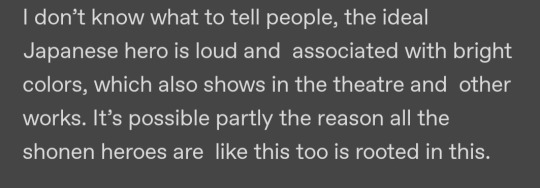
You can only come to the above conclusion if your only consumption of Japanese media include post 1980 Shounen or Toukatsu TV.
Theatre/Kabuki were enactment of the existing literature and I can assure you that their protagonists were FAR from the modern Shounen protagonists( I discuss this in detail below ).Almost every character in Kabuki has exaggerated make up and wore bright colour, it's not reserved for the protagonist either.
"The Ideal Japanese Hero"
This is a very broad term in itself that doesn't take into account the time period nor genre.
The character traits typical of a Shounen protagonists that presumably OP is talking about such as being short tempered/rebellious/punkish appears very late in the history of manga. These protagonists exhibited such qualities to be relatable to adolescent boys but they are not the ideal conception of masculinity in Japan and they are often criticised for being immature.
These characteristics are often not found in Seinen/Gekiga works, or any literature that is not targeted at kids.It consists of a very diverse variety of protagonists but they are much closer to the Japanese equivalent of a Byronic hero than a loud troublemaker. Take Blade of the Immortal , Vagabond , Berserk , Vinland Saga etc.
Back to Sasuke : Revenge and Restoring Honour
These are the topics that are so embedded in classical Japanese literature that there is an entire Genre dedicated to it : Jitsuroku
The one that started it all i.e Forty-Seven Ronin tells the story of revenge against a political opponent who caused the death of a Samurai lord by wrongfully framing him. This story and it's themes are embedded deep in Japanese heritage and remains one of the most influential works that would inspire similar stories.
The story of being wronged due to politics, resulting in dishonour and ultimately death and then being avenged by the protagonist who sets out to fulfill his duty of revenge and restoring their honor owing to filial piety or loyalty becomes a staple genre. One of the examples being Tales of Jiraiya, one of the many inspirations for Naruto
And Sasuke is a textbook example of such a character from this genre.
He is the typical classical Japanese male protagonist
Despite being a deuteraginist he challenged Naruto's role as a protagonist both in the text and outside of it . During the run of Naruto on Weekly Shounen Jump , Sasuke would occupy the #2 position for the vast majority of times and even beat Naruto at least once to take the #1 spot. His character and story arc was incredibly popular in Japan because it exhibited characteristics of a classical Japanese hero.
He might get mixed reactions in the West but he is beloved in Japan. So much so that some people wanted him to be the protagonist instead of Naruto.
Naruto while a beloved protagonist is considered too naive,and almost childish in his beliefs . While Sasuke is his mature counterpart who is capable of ideological introspection.
Blogs that are in favour of putting the 'heroine' role on Sasuke often use a comment made jokingly by one of the anime directors as Sasuke being the true heroine because he is to be chased and rescued by the protagonist or claim that some Japanese people discuss him as such and I am ????? Are you serious? This is such a superficial way of looking at their relationship and Sasuke's character arc or even what actually transpired between them that I am not even bothering countering it.
If you could browse 2channel back in the day , you would see hundreds of messages in various threads that Sasuke is apparently the true hero of the story or how they want Sasuke to be the protagonist. There would also be comments about how emasculating Naruto's relationship with Sasuke is but that is another can of worms.
It is a common sentiment in Japan that if Naruto was a Seinen manga, Sasuke would undoubtedly be the protagonist.
Instead of being the 'heroine' or 'feminine counterpart', Sasuke exhibits the reserved, graceful and mature masculinity typical of a classical Japanese hero in counter to the open,exuberant and juvenile masculinity of Naruto.
There are people who claim Sasuke being a bishounen and graceful is him being the feminine counterpart because he is the Yin to Naruto' Yang. I highly disagree, Yin-Yang analogy is used throughout the manga to describe contrasting forces especially darkness/hatred and light/love , it is not used to portray outward characteristics. Using Yin-Yang to explain their appearances or behaviour is just extrapolating using the philosophical concept outside of its use of the manga.
While femininity is associated with Yin, I would like people to introspect what 'feminine traits' in the Japanese context constitute. Because the 'feminine traits' that Sasuke apparently exhibits aren't feminine at all.
Sasuke-Naruto are not the only two duos with such outward contrasts anyways , it's predecessor duo and one of the most recognisable rivals (at least in Japan) like Rukawa-Sakuragi from Slam Dunk, which Kishimoto likely took inspiration from has Rukawa who is aloof and desirable vs Sakuragi who is more of a delinquent in both appearance and behaviour . Such contrasting outwardly attributes are present in a lot of Shonen rivalries, you don't need Yin-Yang concepts to explain these.
On this tangent I would actually recommend everyone to read Slam Dunk not only because it is good but to also actually understand how a normal Shonen rivalry between likely straight males works and how much of a deviation Sasuke and Naruto' relationship is. I mentioned before that Kishimoto likely took inspiration from this and I say this because in addition to Rukawa-Sakuragi's rivalry in the sport, there is a love triangle aspect to it. Sakuragi loves Akagi who has a crush on Rukawa, who doesn't care. Here's where the similarity in the dynamics ends. Sakuragi actually really likes the girl ,he only starts playing basketball to impress her and then develops a rivalry with Rukawa. I can go on about their similarities and Kishimoto's subversion but it's a topic for another post.
Getting back on topic.
Sasuke's Desirability and Beauty
One of the most common arguments that is used in favour for Sasuke as a heroine is that he is desired by multiple people in the story and how his beauty is commented and highlighted on, and that these are the features apparently typically given to the female love interest.
This is one of the most ignorant claims I have ever come accross. Japanese literature has a long-standing tradition of exalting the beauty of males and their desirability, often to denote how perfect and/or otherworldly the person is.
One of the seminal works in Japanese literature Tales of Genji had to say this about its protagonist Hikaru Genji : "His appearance tempted men and women alike, as he had smooth white skin, excellent fashion sense, which increased his fame and popularity". His beauty is commented throughout the novel and he is desired by many, this doesn't negate his very masculine character.
It brings me to the next topic:
Bishounen
This is a term with so much history and what tropes it is associated with changes according to what genre it is used in that I am not surprised that some people just use it as a synonym for feminine/homosexual men. But in the contemporary lexicon and usage it just means a pretty boy of any sexuality.
Bishounen serve as love interests in Shoujo, the entire cast in a BL, Antagonist/Rival and sometimes even the protagonist in Shounen and Seinen. It just means a man who looks handsome/beautiful in a androgynous way but at the same time not be mistaken for a girl.
I came across this post and this is what put me over the edge to actually create a proper post because the claims here are completely eregrious

" saying Sasuke is meant to be a typical Japanese ideal of masculinity....... wearing lipstick crazy"
I don't think that the author drawing Sasuke with stage makeup on a cover featuring him as an actor negates the fact that Sasuke is meant to be a typical Japanese ideal of masculinity, I have already discussed it in detail above the reasons he is considered such.
"call Sasuke the Japanese ideal of masculinity... funny... meant to be bishounen"
OP themselves doesn't have any Idea on the Japanese conceptualisation of masculinity nor the term Bishounen, which is fine if they weren't scoffing at an objectively correct reading of a character due to their own ignorance.
Being beautiful, youthful and desirable is well within the form of Japanese masculinity. Being bishounen doesn't negate masculinity, on the contrary validates it.
The sublime masculine Samurai were obsessed with keeping youthful appearances. And there is a reason almost all Japanese male idols/actors/singers strive to look androgynous.
I don't think Sasuke/Sakura shippers refuse to accept that he is Bishounen, that's quite literally one of his appeals,it's a general term not exclusively used to describe homosexual men. The origins of the term definitely contains homoeroticism but as I have said before that in contemporary usage it just means a pretty man and can be found in almost all type of Japanese media.
However if anybody uses the 'Japanese Ideal of masculinity' as an argument against him being attracted to a man, they would be displaying ignorance as these are concepts which can be found in a complementary fashion throughout Japanese literature.
Bishounen also has different tropes associated with it depending on the genre:
Comics for younger boys tend to use arrogant bishōnen in the role of the recurring minor rivals readers love to hate, though their effeminate good looks there, they will often appear older... stronger, and thus in fact more masculine than the commonly shorter and less mature protagonists.
- Manga: The Complete Guide, Del Rey
I think many people cannot let go of their Western sensibilities when analysing the text, especially in relationship to concepts like masculinity which is very dynamic even in Japan. They see two contrasting masculine characters: one being more open and brash and the other being reserved and graceful , and come to the conclusion that the latter is the feminine counterpart , which cannot be further from the truth.
Either that or some people are affected by their bias towards a certain pairing dynamic.
TL;DR Sasuke is the embodiment of classic Japanese masculinity
76 notes
·
View notes
Text
Thinking about the scene in mizoguchis the forty seven ronin where the ronin are gaily joking and playing the flute on the eve of their mass suicide-execution after surrendering themselves, and the scene in four lions where the four surviving mujahideen are jamming to “dancing in the moonlight” on the van ride to the marathon where they’re about to blow themselves up as suicide bombers. How despite the obvious objective similarity in the social behaviour depicted (a group of men in joshing recreation while awaiting a mass self-inflicted martyrs death in the service of a grand ideal, after preparing for an extended period of time) the effect of the scenes is precisely opposite: in the one, to heighten the image the film has building up until that point of the ronin as superhuman unflinching heroes of duty and chivalry; in the other, to further the sense of the terrorists as both unserious and relatably/merely human. Wondering what it is that makes the emotional tone diverge so much, whether it’s purely in the buildup or at least partly a quality of the scenes in isolation as well, and which is a more “accurate” portrayal
67 notes
·
View notes
Note
Any similarities between Shugen and Chobei?
Haven't seen it discussed before but it looks like some parellels can be drawn.
Aza Brothers & Shugen; Stories of Samurais

I think they are not really parallels of each others, other than being antagonist of the story. Chobe is parallels with Gabimaru, even though they are on opposite sides, they are smilar. Because they both are tragic character who does anything to protect the ones they love. And Shugen is parallels with Sagiri but in a way that they are different, even though they are supposed to be on same sides as yamada asaemons. But they are different because Sagiri questions what she believes in while Shugen is just a wall.
But even so, there is interesting connection between Shugen and Chobe and also Toma. Its not the connection between characters but what they represent. Its so interesting how author write samurais in his story. How their honor and pride was so important for them that it drives them insane.
First with Aza brothers backstory. There is a reference to historical event.



The revenge of the forty-seven rōnin (四十七士, Shijūshichishi),[2] also known as the Akō incident (赤穂事件, Akō jiken) or Akō vendetta, is a historical event in Japan in which a band of rōnin (lordless samurai) avenged the death of their master on 31 January 1703.[3] The incident has since become legendary.[4] It is one of the three major adauchi vendetta incidents in Japan, alongside the Revenge of the Soga Brothers and the Igagoe vendetta.[5] The story tells of a group of samurai who were left leaderless after their daimyō (feudal lord) Asano Naganori was compelled to perform seppuku (ritual suicide) for assaulting a powerful court official named Kira Yoshinaka. After waiting and planning for a year, the rōnin avenged their master's honor by killing Kira, knowing full well that the authorities would likely not tolerate this vendetta's completion and put them to death. Due to considerable public support in their favor, the authorities compromised by ordering the rōnin to commit seppuku as an honorable death for the crime of murder. This true story was popularised in Japanese culture as emblematic of the loyalty, sacrifice, persistence, and honor that people should display in their daily lives. The popularity of the tale grew during the Meiji era, during which Japan underwent rapid modernisation, and the legend became entrenched within discourses of national heritage and identity. (Source.)
In Jigokuraku story, basically their lord was punished and their ronin was also punished as well for their Lord's crimes. Chobei and Toma were basiclaly samurai's kids and they lost everything. Because of what happenned, they suddenly became poor which lead their mother to became sick and died. Their father tried to take revenge with other samurai friends and eventuall he was executed. As result, Chobei and Toma were left alone at streets.
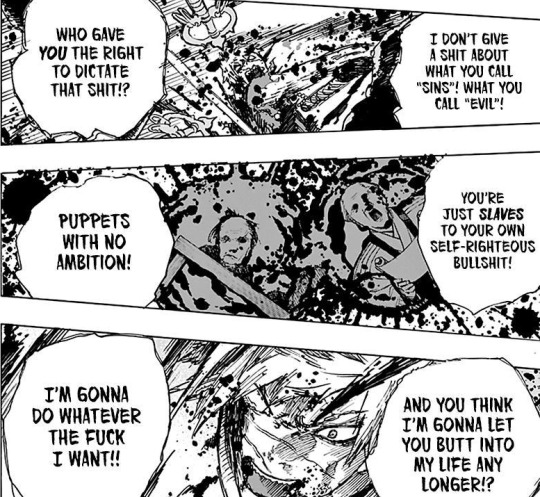
This case also became their 'villain origin' story. Their entire motivation to become criminal (other than survival) is result of being traumatized by this event. It is very interesting to explore their reaction to this during the story.

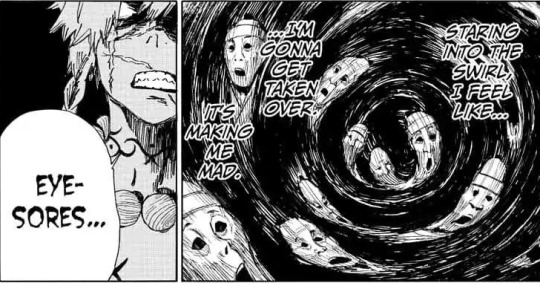
They dont believe in justice and anything represent it. They dont care about honor or honesty anymore. They are literally bandits, opposite of samurais, they lie, they steal. Its almost like reflection of their hatred towards society and especially samurais or blowbacks of samurais' obeying orders without a question.

They dont believe in justice. Toma seems to be the silent type who accepts his fate when is in terrible sitution. Meanwhile, Chobe lash out and he is triggered whenever someone talk about 'punishment' or whenever he is reminded of 'samurais' to the point he accidently hurts his brothers. He said he hates people who blindly follow things without a question and he is his own god.
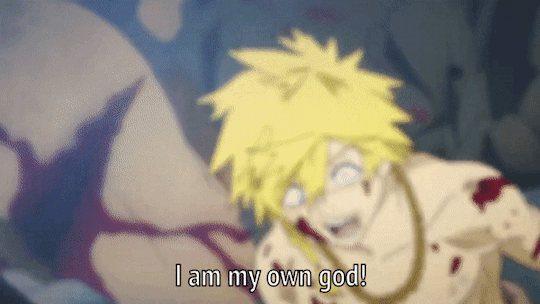
Freedom, making own decisions is very important concept to Chobei and i think it is something samurais (and even asaemons in story) lacks.
They care about things like honor and rules too much to the point they act injustice. Even someone kind person as Shion was about to kill Nuruga despite the fact that she is innocent, just because rules said otherwise. And Sagiri as someone who doubts, she is rising as heroine and she is connecting criminals and asaemons together.
The point is; Story is criticizing samurais obsession with certain rules to the point they act insane while it explore humanity of criminals and most of them are just victims who try to survive.

Chobei and Toma also seems to hate 'people gathering together'. Those two just stick together and there is always distance between them and other people.
Chobei says just two of them is enough and Toma literally says he hates group thing, while he is remembering his father gathering together with other samurais.

They love their father but they clearly traumatized by what happenned. They both see their father's death as abandonment. Their father chose his honor, his revenge, his samurai friends, 'justice' above his kids and his wife. And as response to that, Aza brothers decide to chose each others over everyone, every friends they could make, every revenge plot or even justice. Because Chobei and Toma, their father abandonded them. We can see in their narrative, that Chobei says 'I know Toma, i am not like our father. I will come back to you.' and when Chobei 'died' at the end, Toma says 'whats your difference than our father then'. Its like a code between them. They see any kind of separation as abandonment. Worst part of all of these is that they know that their father loves them but because of that happenned, they have serious abandonment issues.
Basically, every part of their character is connected to this event. Samurais world was so insane and unfair that kids of samurais became bandits result of it.

On the other hand, there is this Shugen who symbolizes everything wrong with samurais world. He is so obsessed with punishment, justice, honor, that he killed innocent family (including babies) to punish the criminals, he also killed his asaemon friend Fuchi.
This obsession with honor and justice can be said for other asaemons, samurais but Shugen is the most extreme one with his ways so yeah.
Apperantly, Shugen is reference Momotaro, popular hero of Japanese folklore. Author mentions this in his interview.

Momotarō was born from a giant peach, which was found floating down a river by an old, childless woman who was washing clothes there. The woman and her husband discovered the child when they tried to open the peach to eat it. The child explained that he had been bestowed by the gods to be their son. The couple named him Momotarō, from momo (peach) and tarō (eldest son in the family). When he was just five years old, he was able to cut a big tree with just an old knife. When he matured into adolescence, Momotarō left his parents to fight a band of Oni (demons or ogres) who marauded over their land, by seeking them out in the distant island where they dwelled (a place called Onigashima or "Demon Island"). En route, Momotarō met and befriended a talking dog, monkey and pheasant, who agreed to help him in his quest in exchange for a portion of his rations (kibi dango or "millet dumplings"). At the island, Momotarō and his animal friends penetrated the demons' fort and beat the band of demons into surrendering. Momotarō and his new friends returned home with the demons' plundered treasure and the demon chief as a captive. (Source.)
Shugen's story is also similar to this kid. His family was murdered and later, he became asaemon, proves his talents with blade. He is even given present by Shogun and he kills/punishes anyone who disobey the laws. This is shown in Jigokuraku novel too.
This is interesting because Momotaro is just a hero but Shugen is clearly written to be twisted and dark version of it. He is someone never doubts or questions his beliefs, the darkest side of asaemons. Because even just simple well intention might end up with something bad if you never think you might be the wrong one. Or if you dont have mercy or empathy. Shugen is also a tragic character who hates criminals because they killed his parents and eventually molded by samurais, this lead him to be righteous and obsessive and he also chose to not change despite tha fact that he made friends.
As bonus; Momotaro also kills demons/bandits and Aza brothers are kinda similar to Blue Demon and Red Demon, as two demons who was treated unfairly by normal people. More details in here.

So this is the connection i think they have. Its not the parallels. Its the story of samurais. And there is always a two sides to same story. Aza brothers who are criminals eventually turn out to be tragic villains, they become allies to their enemies because they change for better while characters like Shugen who is someone supposed to be hero eventually become enemy to his allies because he remains the same.
Story also explores the ideas of invidual vs greater good with their story. One would destroy the world to protect his brother, ıother one would kill his friend with the name of justice. Both ways are extreme but Chobei's (and Toma's) main motivation is love for one person and since his conection is real, a person, he can rise but in Shugen's case, his motivation is ideals, for bunch of invisible people that he has no connection with, instead of focusing people near him, he chose to ignore it for the sake of ideals, thats why he falls. Its interesting.
I wish we explore this side of story in more details, its very interesting, and deep, and fun.
#anon ask#jigokuraku#jigokuraku analysis#jigokuraku meta#aza chobei#aza chobe#aza toma#hells paradise#yamada asaemon shugen#jigokuraku parallels#yamada asaemon sagiri#gabimaru#sagiri#47 ronin#momotaros#samurai#tw trauma#aza brothers#hell's paradise
21 notes
·
View notes
Text





47 samurai 四十七士, shijūshichishi
also known as Akō incident (赤穂事件, Akō jiken)
A historical event in which 47 rōnin avenged the loss of their master on January 31, 1703, fully aware of their consecutive death. A legendary moral example of integrity and respect to the samurai principles.
Asano Naganori lord of Akō (now in Hyōgo prefecture) was invited to Edo (now Tokyo) as the 4th member of the official reception group for imperial envoys arriving from Kyōto, during shogun Tokugawa Tsunayoshi's rule. Kira Yoshinaka, retainer of the shogun, had the duty to inform them about the court etiquette.
Kira, annoyed by lord Asano's lack of manners (he didn't offer Kira some informal but hefty bribe/prasent), became insultingly rude. Asano lost his temper, drew his sword and inflicted Kira a minor facial wound, but a sword drawn inside the shogunate was a grave breach of protocol and Asano had to commit ritual suicide at once.
The forty-seven samurai of Asano's bodyguard, reduced to ronin, decided that their code of honour demanded revenge. Taking to ostentatious idleness and dissipation to put both Kira and the authorities off guard, they waited for almost two years. While the oldest, who was in his eighties, was excluded from the attack as witness and messenger of the events, on the night of January 30, 1703, they attacked Kira’s mansion, killed several of Kira's samurai, found him scared shirtless hiding in a closet and decapitated him.
The avengers washed and carried the head to Sengakuji Temple and put it on their lord's grave.
To this day, the story remains popular in Japan, and each year on 14 December, the temple where Asano Naganori and the rōnin are buried, holds a commemorative festival.
Fictionalised accounts of the tale of the forty-seven rōnin are known as Chūshingura. The story was popularised in numerous plays, including in the genres of bunraku and kabuki. Because of the censorship laws of the shogunate in the Genrokuera, which forbade portrayal of current events, the names were changed. The first Chūshingura was written some 50 years after the event.
Utagawa Yoshitora: 47 (45) Ronin Portraits, ca 1840. Ukiyo-e
https://www.britannica.com/event/47-ronin
https://en.wikipedia.org/wiki/Forty-seven_r%C5%8Dnin
https://www.historytoday.com/archive/months-past/forty-seven-ronin-incident
6 notes
·
View notes
Text
Disillusion
Written for @Koenma-week
Summary: Koenma isn't very old when he becomes disillusioned by his father. When his eyes awaken to the truth. (angst, trauma, child abuse, xenophobia, about 2k words)
***
Koenma is fourteen, a true fourteen, when his father lets him come to work.
Enma looks at his child, strokes a measuring hand down the top of his head, and tells him, "It's time you felt what your first stamp on a life's contract does." He looks pleased at the thought, and Koenma is only a little frightened by his father's expression.
His father's smiles never looked... happy. Just cruel, superior, and unkind.
Koenma often feels small in his father's presence, the height not having much to do with it. His father has an important job as ruler of the spirit world, the person who judges the dead, at least for Japan, and a section of the Makai. But that position is revered and makes his father a powerful man.
A mountain that Koenma's not sure he can measure up to.
"Remember, as high as we are, there's always someone higher, and while we never see them, we must listen. But also remember," Enma says with a sneer, "We are better than the other rulers of the Spirit world with their pitiful territories. The rulers over the territory in China, for instance, have four rulers, instead of one---they are so inferior! And the Americas are so pathetic, that they have Ten! Ha! Ten rulers needed to judge a simple soul, and keep an eye on their district!"
Koenma lets his father ramble, uncomfortable by his father's words. He is still young and doesn't know how to explain that his father's words are unkind and make him feel... wrong. He also holds his tongue in pointing out that the territories that have more leaders, are also larger, and therefore might need more hands in aiding all the work.
Surely, judging a soul is not an easy task.
"Here we are son," Enma says at last, guiding the inexperienced prince into the office. "Sit down. I am going to give you a paper, you read it aloud to the spirit, and then judge the soul. I have the stamp and seal left out for you."
Koenma is guided into a cushy seat, and an overlarge desk. The chair on it's own adjusts its height to the desk, usually meant for his father's size, and not his. His feet dangle high off the floor, and he feels even younger and more inexperienced as he waits behind the desk, that is meant for a frame six times his size.
His father takes a place against the wall, and Koenma looks down at the desk. There is one sheet of paper before him, a pad of red ink, and a golden seal. He itches to touch it instincts telling him that this is duty, to hold the heavy stamp in his hand, but he keeps his hands folded on the table and waits.
The spirit that is marched in is middle-aged Ronin, with long black hair. His back is straight and his brown eyes are at peace. Uncomfortably, his body is riddled with arrows, in his chest and back, but the spirit does not seem to notice them. The Ronin marches before Koenma, and then takes a seated kneeling position, his hands resting on his thigh as he awaits judgment.
Koenma nervously takes up the paper, and ignores how his voice cracks as he reads the document, "Hoshino Ryota, age forty-seven. Died in battle against the feudal lord of his territory."
"Yes," The spirit answers when Koenma pauses.
Koenma shoots a nervous glance at his father, to see if he has already messed up what he was supposed to do, but Enma does not look at him and instead remains passively facing the front.
Koenma licks his lips, and returns to reading, "Hoshino picked up his sword and led a rebellion against the lord of his territory due to his lord's crimes. As Hoshino is the loser of this battle, he shall be sentenced to wander in hell for a hundred years, before a chance of reincarnation."
The Ronin's mouth ripples, and he closes his eyes.
He does not voice a complaint against the sentence.
Koenma rereads the paper, the short document disturbing him deeply. He turns the paper around, looking for more details, but he finds none. 'This can't be right...' Koenma thinks, and traces the words, '...led a rebellion against the lord of his territory due to his lord's crimes.'
The words glow, and new words spring to life, an extension adding to the paper.
Koenma reads it aloud eagerly, "The lord's crimes consisted of heavy over taxation, stealing of crops, abduction of women, and children, murder, and rape."
Koenma blinks at the lengthy list of sins, and mutters, "Well then Hoshino Ryota had every right to rebel!"
Enma clears his throat, and Koenma jumps to look at his father. Enma is not looking at him, but his face is red with clear anger. Koenma is doing something wrong. Sweating now, Koenma slides his eyes to the Ronin, who is sagging a little in his seat, the weight of despair heavy on his shoulders. He still says nothing against Koenma's earlier sentencing, but his eyes look up at the anxious Prince.
The warrior's eyes ask for nothing and expect nothing.
This human's soul, does not expect justice or kindness, and Koenma's insides twist as he realizes it.
He adverts his eyes quickly away and picks up the stamp.
'Am I really just supposed to send him away to hell? Just like that? Isn't a hundred years a whole lifetime for a human?' Koenma thinks, his mind busy with what he should do.
He touches his finger over Hoshino Ryota's name and wills a question into the name: What were Hoshino Ryota's actions during the rebellion?
Words flooded the paper, and silently Koenma read to himself, 'Hoshino Ryoto robbed from the wealthy Lord and his vassals, and distributed money, goods, and food. He freed slaves and hostages. He spared those who could no longer fight and allowed those not involved in the rebellion to flee the battle. Common sins: Lying, stealing, and envy. Uncommon sins: Murder during times of war.'
This list of Common sins and Uncommon sins made Koenma's head buzz harder. This was a lot to absorb. The common sins were what Koenma might expect from any mortal, and even the uncommon sin of murder was understandable, given the fact that the Ronin was in the midst of a rebellious war. Was the document counting death in times of war, as murder? That couldn't be right... it certainly wasn't fair!
Koenma remained silent, knowing he had no one to ask... or at least no one who would answer.
Koenma, having more confidence with how this paper worked, trailed his hand down the sentencing and tapped it. At his touch, the sentencing changed. Koenma smiled, cycling through suggestions of sentencing. It seemed the Ronin could not get away without going unpunished for being "the loser," of his rebellion, but Koenma saw no reason to judge the man harshly.
Judging someone for losing in battle delt pedantic at best, and plain stupid at worst.
He settled on a new sentence, that he found to be more befitting of the mortal, cleared his throat, and read aloud, "Under reconsideration of the mortal's struggles, As Hoshino Ryota is the looser of this battle, he shall be sentenced to wander in hell for three years before a chance of reincarnation, or a chance at peace and rectitude in the level beyond."
Koenma pressed his stamp into the red pad of ink and then stamped the document.
The paper disappeared into gold light, and Koenma felt a small bit of warmth flood his body, generating a renewing sense of energy inside him he had never felt before. He lifted his head and saw the Ronin had bowed low to Koenma. When he got up, there were tears in his eyes, and while the warrior still kept his silence, he looked at Koenma with a face of gratitude and wonder. He rose to his feet, and his human form fell away, and he became an orb of spiritual essence, bobbed what looked like a bow, and turned away, floating outside the large doors he had come through.
'That felt good!' Koenma thought with a smile, pleased with his handling of that sentencing.
And then his father curled a mighty hand around him, holding Koenma like he was a mere doll in his meaty fist. Enma shook Koenma hard, Koenma's head snapping and rolling painfully as he was shaken around wildly. Enma howled, "You little fool! You were to read the paper and stamp it! That was it!"
"F-Father! Father wait," Koenma cried, feeling sick from the dizzying shake, "But... but his circumstances, the crimes of his lord-"
"His lord will be judged when he comes here!" Enma snapped. The paper does it all for us! You read it, stamp it, and move on!"
Enma threw Koenma who went skidding across the marbled floor before he smacked into an ornate pillar, the wind knocking out of him as he collided against it. He curled against the piller atrying to catch his breath.
"Foolish little idiot!" Enma raged, "Do not make your work harder! You were supposed to stamp the paper and experience the completion of a contract, that was it!"
"But I... that warmth," Koenma managed when he could find the words to speak, "That... that warmth, I felt it. When I... when I completed the contract. When I stamped-"
"That is nothing!" Enma snapped dismissively. He heaved a great sigh, and put his fingers to his brow, "That little bit of energy is nothing! Don't you know, the harsher the sentencing, the more strength we get?! If you want to become a giant like myself, you will learn to do as the paper says!"
Enma lumbered over to his cushy seat, and sank into it with a depressive sigh, "You disgust me. Away with you. When you are a hundred years of age, we will try this again, and if you do it correctly, I will entrust you with work. But not a moment before!"
Koenma painfully got on all fours, his spine popping sharply as his back muscles spasmed.
"Get out!" Enma roared, slamming a fist on his desk.
Koenma was forced to crawl out of the office, his body hurting too much to allow himself to attempt to stand, let alone walk.
"Oh dear, oh dear, Lord Koenma, are you alright?" A kind voice said, as he made it past his Father's ornate office doors. Gentle hands fell on his back. He looked up into the face of a concerned blue-haired woman, her pink eyes wide with concern.
Koenma made to speak, but found there was nothing to say.
What was he supposed to say?
The woman's hands glowed, as she pressed a shooting golden energy into his back, something that was reminiscent of what completing the Ronin's life contract had felt like. After a moment, he was well enough to stand, and the woman kept a hand around his waist as she offered to walk him back to his room.
Swirling with the realization of his father's true face, Koenma quietly accepted it, and let her walk him down the hall. She babbled at him, but he found that he could not focus on her words, or find his own words to say, even if he longed to talk, to ask questions.
Was his father always like that?
To employees?
To souls?
Did he never consider lessoning a mortal soul's burden?
Even if they had suffered?
"It'll be okay..." The woman's words finally registered just outside his bedroom.
He looked at her, her face cast down to the floor, "You'll get used to it."
Koenma's eyes flashed, and a golden flicker burned in his eyes, "No."
She turned to him, and he shook his head, "No... I will never get used to it. I will never judge like that."
"My prince," the woman whispered, pink eyes gentle with concern, "if you don't, then you will amass power slowly, and your journey to Godhood will become stunted. You'll never be the massive form like your father... you'll be small, weak. A child in comparison."
"Better a child who knows better... than a giant monster who doesn't," Koenma reasoned, before pushing away from the woman, to go into his room and rest.
There was a lot to think about, a quiet rebellion stirring in his heart.
Things could not remain this way.
Before he shut the door on the ferry woman who was staring at him with open shock, he wondered privately, if that little bit of strength completing Hoshino Ryota's contract, had been the man's will. The will to lead a rebellion against cruelness and tyranny.
Time would have to tell Koenma how brave he could be.
12 notes
·
View notes
Text
Kamiya Dojo Monogatari Tale 60(JUMP SQ 22/12)
About Kamiya Dojo Monogatari:
Tales of Kamiya dojo is written by Kaoru Kurosaki and published along with the “Rurouni Kenshin Hokkaido” arc in JUMPSQ. The tale involves the Rurouni Kenshin character in daily life that takes time between Kenshin and Kaoru marriage until the epilogue chapter in the original manga before the Hokkaido Arc. Until this month (December 2022) there are a total 60 chapters in Tales of Kamiya dojo. This is an unofficial translation.

Previous story: https://www.tumblr.com/kenkaodoll/697968263665254400/kamiya-dojo-monogatari-tale-59-jump-sq-2211
Sekiya Village, where Miyako lived, had been known as a scenic area since the Edo period (1603-1867), and had been depicted in numerous ukiyoe woodblock prints including "Fugaku Sanjurokkei" (Thirty-six views of Mt. Fuji), "Edo Meisho Hyakkei" (One hundred Famous Views of Edo), "Eight Views of the Sumida River", and "Sekiya no Sato" (Sekiya Village) in Edo's famous collection of paintings.
It was also famous as a cherry blossom viewing (*Hanami) spot, and the area where well-branched cherry trees were planted alongside the Sumida River was especially crowded during the cherry blossom viewing season.
However this large crowd at the cherry blossom viewing was a problem for the villagers.
Although civilization had developed, entertainment was scarce in this era. The passion that people put into Hanami was not half-hearted.
The Hanami was a time for people to lay out mats under the cherry trees, bring lunch boxes and sake, and spend a lively time drinking and singing among good friends.
But before anyone realized, the "drink and sing" part had turned out to be more violent.
During the party they performed a play with real property and got absorbed into it that even*the traveling troupe would be surprised to see them. The people drank a lot of sake, and the drunks fought with each other.
People ignore the sword prohibition and all use their *wakizashi, so a big fight between drunken people turns into a bloodshed incident involving wakizashi which were meant to be property for the play.
・
“So when the big quarrel happened and the guy started to draw their wakizashi, I paid Zanza the street fighter to take care of them.”
Miyako shared her story while recalling Sanosuke.
It was still before Sanosuke met Kenshin and the others.
That year, the villagers performed "*Chushingura" at the cherry blossom viewing party.
"Chushingura" is a play based on the "Ako Incident", in which Ako’s *Ronin led by Oishi Kuranosuke in the 15th year of the Genroku Era (1703). They avenged their former master Asano Takumi Nokami by attacking Kira Kōzuke Nosuke residence and killed him and his family members. It was a popular performance and the villagers were so earnest they even took real swords.
“There are 47 Ako Ronin, as in 47 warriors, right?”
“That's right.”
Yahiko was amused.
“There were forty-seven people towards about the same number of people from Kira's mansion. Well, there were about a hundred wakizashi as props for the play.”
“You don't mean to tell me that was real, not just theatrical bamboo property?”
Miyako nodded at Misao's words.
“They are not professional entertainers. They used a real weapon rather than a safe prop because they thought it would add more power to the play. If they were professional actors, even a bamboo property would bring the power like it was the real thing. So, when drunken people got into a fight at a Hanami party, they got into a huge brawl with a hundred wakizashi swinging there.”
“Wow.”
“How scary!”
Both Yahiko and Misao imagined a big fight with real weapons and they spontaneously let out a weird voice.
“At that time, Zanza, who had come with his friends to see the cherry blossoms, fought out everyone who was running amok, regardless of whether they were friend or foe, and all of them were defeated.”
“Somehow, I can picture that behind my eyelids.”
Misao placed her hand against her forehead and closed her eyes.
“Me too.”
Yahiko closed his eyes as well. “It was a fun fight,” Sanosuke's refreshing smile seemed to float across his face.
“I guess they learned their lesson after that, though, and the big fight at the Hanami party calmed down.. But since Zanza didn't show up at last year's, this year's battle game is going to turn into a hostile atmosphere.”
Miyako sighed.
“And, you know, if there were to be a big fight like before, with a hundred wakizashi, people would definitely die, and there were even some hardliners who wanted to cut down all the cherry trees and make hanami impossible before there was any trouble…”
“Cut down a row of cherry trees!”
“That's a terrible idea.”
“I know! Isn't it terrible! I thought that Zanza was the only one who could stop this trouble. But he's not here. We can't just call him back now... It's not going to happen...”
Miyako was disheartened.
“If this keeps up, will they cut down the cherry trees?”
”Maybe...”
“It's not them who caused trouble. The cherry trees are innocent!”
“We already received the vegetables, it’s too late to turn back. Is there anything we can do to help?”
“Hmm..”
Miyako thought for a moment and then said regretfully.
“Probably there’s nothing you can do”
“But!”
Misao persisted.
“We might be able to do something. Let's think about it without giving up. Let's start by looking at the rows of cherry trees and talking to the villagers. Show us around!”
“I'll go with you! Let's go to see the cherry trees in Miyako's village.”
Misao immediately agreed to Yahiko's words.
“Eh!?”
Miyako was a little taken back.
What do the two little guys think they can do? But both Yahiko and Misao are ready to take action for the sake of the cherry trees.
“Let's move quickly. quickly.”
Their spirit pushed Miyako to take them to the village.
・
Even with the reformation, Tokyo in the Meiji era was still connected to Edo (present-day Tokyo). In the present day, many waterways have their tops blocked off as culverts, but at that time in the Meiji era, waterways were still very much in use in Tokyo for distribution and as a means of transportation for the common people.
The distance from Asakusa to Sekiya Village was reached by rowing upstream on the Sumida River. It was a reasonable distance if one walked on land, but it was a short distance if by boat on the waterway.
・
Yahiko and Misao were brought to the village shrine by Miyako.
“*Kan‘nushi… I brought someone!”
Miyako opened the shoji of the shrine office without hesitation and entered, followed by Yahiko.
“Oh, Miyako. You did it... Umm?”
The Shinto priest who greeted Miyako had a big smile on his face, but in an instant, his expression turned dubious.
“Zanza was not so small. As expected of Ochoko Miyako. There is no limit to how ochokochoi (careless) you can be. The only thing that resembles him is his pointy head.”
It seems that the Shinto priest was waiting for Miyako to bring Sanosuke to him.
“I'm not Sanosuke. I am Yahiko Myojin, a samurai from Tokyo! I heard about the problem with the cherry trees, so I came here to help you in any way I can.”
Yahiko introduced himself.
“Only for the sake of cherry trees, I accept your kindness.”
The Shinto priest said.
“Excuse me!”
Misao entered immediately.
“This girl doesn't even resemble Zanza, and isn't she a girl to begin with?”
The Shinto priest said to Miyako in dismay.
“I am Makimachi Misao! I came here to do something useful for the cherry blossoms.”
“Thank you, but a woman and a child can't do anything about the conflict over the cherry blossoms, you know.”
The Shinto priest looked disappointed.
“At least we need someone as powerful as Zanza to glare at them for intimidation.”
“Kan'nushi, about that… Zanza has gone far away.”
“What? He's dead, isn't he? That's why these kids took over for him.”
“He's not dead. Sanosuke is traveling abroad.”
Yahiko thrusted at the Shinto priest who had the same reaction as Miyako. Then he whispered to Misao.
“If they need a strong man to scare the drunks, why not bring Kenshin along?”
”Hmmm... Himura's appearance is not good enough to intimidate them.”
Misao laughedbitterly.
Kenshin was strong, but his appearance was a little too soft for the job of intimidating the drunken man.
“How about Kaoru then? She's pretty scary when she's angry.
“Kaoru-san is a bit...”
Misao laughed even harder.
If only Kaoru had a shinai, she would be as good as any drunkard, but she is still in her flowery age. Even though she had a child, she was still far too young to be able to glare at a drunken man with the force of an old woman (like auntie’s power).
“If you need someone older, how about Megumi?”
“Megumi is not strong enough to begin with.”
“I see. It's not easy.”
Both of them pondered.
“Thank you both for coming all the way out here for the cherry blossoms. It's a little early for cherry blossom viewing, but why don't you take a stroll along the rows of cherry trees?”
The Shinto priest said.
“Let's do that. Let's do that.”
Yahiko and Misao went outside at Miyako's urging.
・
The three of them were walking along a row of cherry trees.
“First, let's get our story straight,”
Yahiko brought up the subject.
“Sanosuke is not here, and I can't think of anyone else at the moment who would be able to intimidate the drunks.”
“That’s right.”
Misao also chimed in.
“We can avoid the big fight with a hundred wakizashi, if we change the program of the play to a more peaceful one without a sword fight, right?”
"Yes, that's true, but..."
Miyako hesitated to say.
“Can’t you stop the fight and drunken brawl by changing the program of the play with something less violent?”
“I guess the only way to settle this matter is to talk it out, huh?"
Yahiko said plausibly.
“Every year, we decide where to sit for the Hanami party by lottery and lay out the mats on the floor. But then, in the middle of the night, some unscrupulous person replaces the mats from the good seat with his own, and we have a dispute over it.”
When they looked under the rows of cherry trees, the mats had already been laid out and set up there. During the daytime, no one changes the mats because people are watching, but ruthless people sneak in at night.
“Then let's set up a guard! Why don't we take turns watching? I'm the one who suggested it, so I'll do it tonight!”
Misao suggested and took the task herself.
“And then we can take care of the drunks...”
It was hard to come up with a good idea for this matter.
Hanami was all about drinking. It was impossible if they could tell people not to drink.
In the meantime, it was time for Yahiko to leave for Akabeko.
“Then I'll send you by boat.”
Leaving Misao at the cherry trees, Yahiko and Miyako returned to Asakusa by boat.
Then when Yahiko was getting off the boat, Tsubame happened to pass by, and the boat was rocked by the waves.
“Oops!”
“Ow!”
Miyako hugged Yahiko.
“...!”
Tsubame looked at them with wide eyes.
Notes: *)Hanami : Literal flower viewing, a party for cherry blossom (Sakura) viewing *)Wakizashi: Short swords *)Traveling theater troupe who performs plays on the street *)Story of the Forty-seven Rōnin, the Treasury of Loyal Retainers, Chūshingura *)Ronin: masterless Samurai *)Kan-nushi: shinto priest *)Shoji: sliding door *)shinai (bamboo sword)
.…..to be continued in chapter 61…… https://www.tumblr.com/kenkaodoll/704249471333203968/kamiya-dojo-monogatari-tale-61-jump-sq-2301
TLnote(1): translating Japanese is so hard because the sentence structure is very different compared with English. Also the style of writing is different, plus there’s a lot of figurative, poetic language and things that don't make sense if it’s directly translated into english. So forgive me if this is very weird to read, and please tell me if you want to give corrections.
TLnote(2) I will provide the original Japanese text for correction if any of you who read have better knowledge of the Japanese language. Just dm and I’ll send the file.
TLnote(3) Dtninja had translated some earlier chapters on his website. You can go and check on there
Read the rest of the tales here https://www.tumblr.com/kenkaodoll/686193523858538496/rurouni-kenshin-tales-of-kamiya-dojo?source=share
#Kamiya Dojo Monogatari#Tales of Kamiya Dojo#Rurouni Kenshin#Ruroken#Myoujin Yahiko#Makimachi Misao#Himura Family#unofficial translation#Kurosaki Kaoru#Kaoru Kurosaki
8 notes
·
View notes
Text
14 December, 1702
On this day in 1702, one of the most famous episodes in Japanese history took place, an event which is now universally referred to as the Forty-Seven Rōnin Incident, also known as the Akō incident (赤穂事件 Akō liken) or Akō vendetta. https://youtu.be/b6_kbydqEuE
The 18th-century historical event refers to a band of rōnin (leaderless samurai) who avenged the death of their master, Asano Naganori, lord of Ako, who was forced to commit ritual suicide following an earlier attack on Kira Yoshinaka, in grave breach of protocol, at the shogun's court in Edo.
A noted Japanese scholar has described the tale as the best known example of the samurai code of honour, bushidō, and as the country's "national legend."
Shown here is 1926 lithograph (from my personal collection of Japanese art) - known as "The 47 Rōnin Memorial Portrait" - which shows all of the participants in the legendary attack.
There are, of course, many other depictions of the historical event in ukiyo-e form by the likes of Utagawa Toyokuni (歌川豊国; 1769– 1825), usually referred to as Toyokuni I; Katsushika Hokusai (葛飾北斎, 1760-1849), Utagawa Hiroshige (歌川 広重, 1797-1858), Utagawa Kunisada (歌川 国貞; 1786 – 1865), also known as Utagawa Toyokuni III (三代 歌川 豊国), and so on.
A number of successful films have, naturally, also been made detailing the Forty-Seven Rōnin Incident, the first of which was directed in 1912 by Makino Shozo.
For anyone in Japan who is interested in such things, it is still actually possible to make a visit to the site of the graves of the forty-seven Rōnin (四十七士 Shi-jū-shichi-shi), ranging in age from fifteen to seventy-seven, which are located at Sengaku-ji (泉岳寺), a Sōtō Zen Buddhist temple in the Takanawa neighbourhood of Minato-ku, near Sengakuji Station and Shinagawa Station, in Tokyo.

4 notes
·
View notes
Text
Lessons from Chusingura – What the 47 Ronin Can Teach Us

Chusingura is the story of how 47 ronin avenged their daimyo with honour. A popular novel in Japan, The New Chushingura – The Forty-Seven Ronin, tells the story of how these 47 vassals of Takumi no Kami, the young, stoic daimyo who was forced to commit seppuku, avenged their master in 1703.
Oishi Kuranosuke was the Chief Retainer of the daimyo who was sentenced to commit seppuku by the then Shogun. He was the leader of the faction that was determined to take revenge against Lord Kira, also known as Lord Kozuke no Suke, the Chief Master of Ceremonies who publicly insulted Takumi no Kami in the Edo palace. The lesson in this essay is largely based on his musings in a chapter of the book.
Dog law and culture
The shogun at that point in history was the fifth in the Tokugawa era. Tsunayoshi was popularly known as the “Dog Shogun” because he notoriously passed the Edicts on Compassion for Living Things, which outlawed “cruelty” to dogs. This may be inspired by the fact that he was born in the year of the dog.
As a result of this law that protected domesticated animals, the status of humans was relegated to a level below dogs. If a person, even a samurai, mistreated or even deemed rude to a dog, could be punished for the offence.
In a chapter largely filled with musings of Oishi, he reflected on how this dog law permeated the culture of Japan. He saw how some people behaved like dogs and, thus, became elevated in society because of their dog-like servile and ingratiating behaviour. These people were not only found amongst the peasants, but also in noble circles of samurai.
“We will reluctantly walk without spirit, depending on the time, we become humans or become dogs.”
As a matter of course, these “dog people”, regardless of their place in society, advanced in their respective fields because they complied with the feudal Dog Culture that not only spread fear, but also taught people to be subservient and promoted sycophancy.
“In this world of esteemed dogs, if the two swords of a samurai, one long and one short, can't be grabbed, they are only discarded. The daimyo abandons being a daimyo; the samurai quits being a samurai; the government official stops being a government official.”
In his musings, Oishi realised that those who chose to remain human have become outcasts because they defy the dog customs and unjust laws of the times. Indignant, he declared to himself, “We are not less than dogs. We are human beings.” Thus, he decided:
“He would give life to the late lord's will. If we don't eliminate the corrupt government of the current shogunate, without clan or connections and the misfortune of being banned from the world, our sole measure must be to walk a path, even if we know previous generations did not follow that path.”
This Chief Retainer of Takumi no Kami, Oishi Kuranosuke, based on honour and courage, chose the road less travelled. We meet very few people like him these days. When he and his colleagues had accomplished their goal of killing and beheading the dog-like Lord Kira, they proudly marched in broad daylight to Sengakuji Temple. Along the way, the public witnessed in awe and admiration. When they arrived at the temple, they declared, "This message is for the guardians of this temple. We are the vassals of the late Asano Takumi no Kami. Tonight, we invaded the Kira estate in Honjo to ask for the head of Lord Kozuke no Suke. We achieved our goal and came to present our offering at the grave of our late lord. Together, we will go to the family cemetery. We ask you to shut the main gate to prevent outsiders from entering when we pass through to his grave and report to our lord's soul."
Gone are the days of such honour and courage.
In 1941, during World War II, U.S. President Roosevelt declared the fundamental objective of the Allied Forces – the promotion and protection of human rights – by proclaiming the 'Four Freedoms' that people everywhere in the world ought to enjoy - freedom of speech and belief, and freedom from want and fear. Alas, that is still a pipe dream. Today, cowardly sycophants ostensibly rule the world. In reality, the elite billionaires dictate the agenda for society to follow and like. In times like these, contrary to Roosevelt’s vision, people cower in fear and desperately seek a decent living, all the while denied their ability to think and formulate their own opinions, much less speak or profess their own beliefs.
Malaysia today
In many ways, Malaysia today is like the era of the Dog Shogun. Of course, the way we got here is not the same. There were no specific laws that made us behave the way we do; however, the feudalistic culture fraught with sycophancy abounds.
If we look at the recent history of Malaysia, we can trace some of the milestones that led to the sad and sickening state of our nation. First, we were subjugated by the British colonialists. In the pursuit of their imperial aims, they suppressed the people to reap economic gains. They called it development.
Then, the independence government of Malaya inherited many British methods and laws, including divide-and-rule tactics and the Sedition Act (1948). Worse, some royal families and elite politicians colluded with the British to control the independence narrative that gave birth to Malaya in 1957. Whilst the Internal Security Act (1960) was enacted by the Malaysian government, It was influenced by British colonial-era legislation used to manage communist threats by using detention without trial. The Malaysian government has continued to use the ISA, raising concerns about its use against political dissidents.
Such draconian laws and political tactics, no doubt, significantly contributed to the culture of feudalism and corruption that evolved and took root in Malaysian society.
It is unnecessary to describe the political landscape and socio-economic conditions in Malaysia today. It is glaringly obvious that yes-men of the highest order are working hard and fast at the behest of the powers that be. And thanks to the crony capitalism that flourished, the Dog Culture has permeated every strata of Malaysian society.
At the top of the food chain, we find the Prime Minister who is appointed by the Agung. In the last election, Pakatan Harapan did not receive a clear mandate from the people. Nevertheless, the current prime minister was appointed despite evidence furnished by the other side that showed their candidate for PM had majority support in the Dewan Rakyat. Then we saw the horse-trading that led to the current Madani Government, which includes Barisan Nasional, an erstwhile enemy. Since then, we can see the blatant political appointments that rewarded the “loyal supporters” of PMX. These dog people got plum jobs in government-linked companies, and crony entrepreneurs either managed to keep high value contracts by switching allegiance, or getting new contracts by reminding the dog politicians how they have supported their party’s struggle since the Reformasi days.
Of course, the Dog Culture trickled down to the grass roots and influenced the behaviour of sub-contractors as well as bureaucrats, not to mention petty traders and clerical staff. And thus, every citizen succumbed to fate and had to choose whether to become a dog to survive, or to stay human and weather the storm.
What do we do
What are we to do in such a milieu? Perhaps this final lesson from the Chushingura is instructive:
“Whatever path life takes, the path selected by each person will be different. However, the person who seizes meaning and a life worth living will enjoy life to the maximum and be immortal.”
Regardless of the times, we will all face difficulties and suffering. Though the circumstances are different, the common thread is the challenge to our “survival”, which can mean livelihood, career advancement, wellbeing of loved ones, and so forth, depending on how we frame the challenge.
At this point, let me ask a couple of pointed questions:
Is it worth living like a dog just so that you get chunks of meat for every meal and lots of toys to play with?
Or should life be lived as a dignified human being that can enjoy the heights of freedom and experience the depths of consciousness?
Patrick Henry famously said, "Give me liberty or give me death!" Like him, I see the loss of liberty as akin to death. We are born full of potential, but we can only flourish if we are free from fear and want.
I dare say that the vast majority of Malaysians are neither free from fear nor want. Most common people are either fretting about their mortgage repayments or desperately trying to catch their next big break in life.
That sounds like how dogs live from day to day. And dogs are never immortalised.
0 notes
Text
Events 2.4 (before 1950)
211 – Following the death of the Roman Emperor Septimius Severus at Eboracum (modern York, England) while preparing to lead a campaign against the Caledonians, the empire is left in the control of his two quarrelling sons, Caracalla and Geta, whom he had instructed to make peace. 960 – Zhao Kuangyin declares himself Emperor Taizu of Song, ending the Later Zhou and beginning the Song dynasty. 1169 – A strong earthquake strikes the Ionian coast of Sicily, causing tens of thousands of injuries and deaths, especially in Catania. 1454 – Thirteen Years' War: The Secret Council of the Prussian Confederation sends a formal act of disobedience to the Grand Master of the Teutonic Knights, sparking the Thirteen Years' War. 1555 – John Rogers is burned at the stake, becoming the first English Protestant martyr under Mary I of England. 1703 – In Edo (now Tokyo), all but one of the Forty-seven Ronin commit seppuku (ritual suicide) as recompense for avenging their master's death. 1758 – The city of Macapá in Brazil is founded by Sebastião Veiga Cabral. 1789 – George Washington is unanimously elected as the first President of the United States by the U.S. Electoral College. 1794 – The French legislature abolishes slavery throughout all territories of the French First Republic. It would be reestablished in the French West Indies in 1802. 1797 – The Riobamba earthquake strikes Ecuador, causing up to 40,000 casualties. 1801 – John Marshall is sworn in as Chief Justice of the United States. 1810 – Napoleonic Wars: Britain seizes Guadeloupe. 1820 – The Chilean Navy under the command of Lord Cochrane completes the two-day long Capture of Valdivia with just 300 men and two ships. 1825 – The Ohio Legislature authorizes the construction of the Ohio and Erie Canal and the Miami and Erie Canal. 1846 – The first Mormon pioneers make their exodus from Nauvoo, Illinois, westward towards Salt Lake Valley. 1859 – The Codex Sinaiticus is discovered in Egypt. 1861 – American Civil War: In Montgomery, Alabama, delegates from six breakaway U.S. states meet and initiate the process that would form the Confederate States of America on February 8. 1899 – The Philippine–American War begins when four Filipino soldiers enter the "American Zone" in Manila, igniting the Battle of Manila. 1912 – Tailor Franz Reichelt dies while testing his self-made parachute on the Eiffel Tower. 1932 – Second Sino-Japanese War: Harbin, Manchuria, falls to Japan. 1938 – Adolf Hitler appoints himself as head of the Armed Forces High Command. 1941 – The United Service Organization (USO) is created to entertain American troops. 1945 – World War II: Santo Tomas Internment Camp is liberated from Japanese authority. 1945 – World War II: The Yalta Conference between the "Big Three" (Churchill, Roosevelt, and Stalin) opens at the Livadia Palace in the Crimea. 1945 – World War II: The British Indian Army and Imperial Japanese Army begin a series of battles known as the Battle of Pokoku and Irrawaddy River operations. 1948 – Ceylon (later renamed Sri Lanka) becomes independent within the British Commonwealth.
0 notes
Text
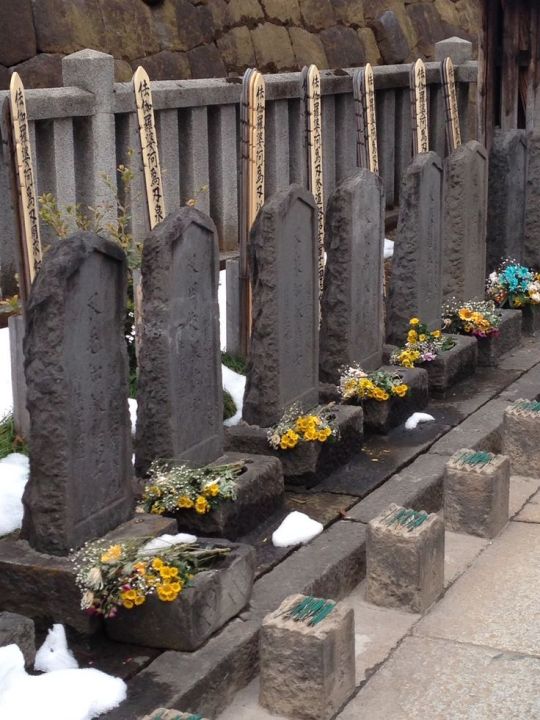
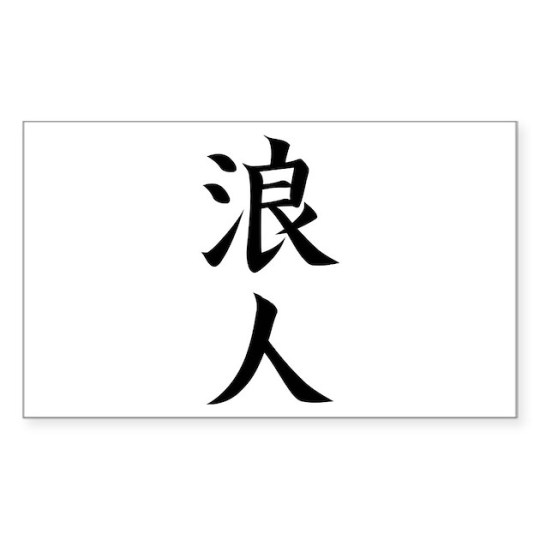
January 31st 1703
Few legends we hear of are true.
In fact some of the finer details of the event that happened on this day in 1703 were lost as its was not permitted to be written about and only spoken of in hushed tones.
In order to avenge the death of Asano Naganori, by the actions of Kira Yishinaka. Forty seven samurai, no longer with a master and branded Ronin, formed a plan to set right the death lead by Oishi.
None of the Ronin came to harm in the storming of the castle but over forty of Kiras men were killed or injured.
In February of the same year, as punishment for their actions, however honorable, they would be allowed a warriors death by Seppuku. All except one, to continue the bloodline of great warriors.
Some official documents still survive of the incident and a shrine exists with the graves.
Warriors and honour should never be forgotten.
Dont forget to Like, Repost and Follow Us
Global Shipping Available
https://store.lawindustries.co.uk/
#lawindustries #tacticaltinkerbell #ubiangelitimere #edc #everydaycarry #military #adventure #tactical #survival #urbansurvival #custom #usa #training #outdoor #bushcraft #rescue #morale #moralepatch #sticker #stickerbomb #business #entrepreneur #militarygear #moralepatches #vinylstickers #militaryoutfit
#law industries#tactical tinkerbell#edc#gearblr#sere#military#tactical#lockpicking#locksport#lawindustries#Tacticalrinkerbell#Ronin#47ronin
0 notes
Video
youtube
Today in History: Jan 30, 1703 – The Forty-seven Ronin, under the command of Ōishi Kuranosuke, avenge the death of their master.
(https://en.wikipedia.org/wiki/Forty-seven_Ronin)
0 notes
Photo

47 RONIN (1941). Kenji Mizoguchi directs a tale of samurai vengeance to restore honor.
#film#cinema#47 ronin#1940s#kenji mizoguchi#mizoguchi#samurai#vengeance#revenge#ronin#forty-seven ronin#japan#japanese#japanese cinema
29 notes
·
View notes
Text

47 Ronin - Dancing in a Meeting, by Ohara Chikuha (1878-1936)
#47 ronin#ohara chikuha#japan#history#painting#fav#ronin#edo period#Forty-seven rōnin#Akō incident#samurai#Ōishi Yoshio#oishi yoshito#Asano Naganori#1701#1702#tokugawa shogunate#samurái#samurais#bakufu
11 notes
·
View notes
Video
youtube
Today in History: Jan 30, 1703 – The Forty-seven Ronin, under the command of Ōishi Kuranosuke, avenge the death of their master. (https://en.wikipedia.org/wiki/Forty-seven_Ronin)
2 notes
·
View notes
Photo
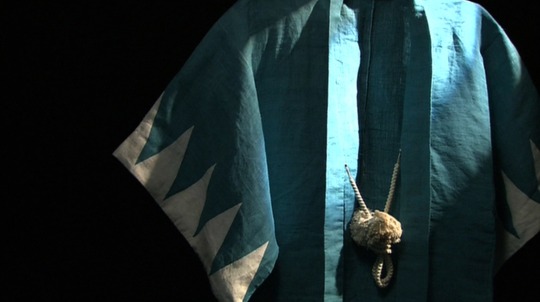

The Shinsengumi’s uniform: asagi blue haori
Part 1
(source: https://shinsengumijapan.com/2020/10/11/haori/)
The Shinsengumi uniform was an iconic light blue color (Asagi-iro) unlined haori. According to the book “History of the Mibu Ronin” (八木為三郎老人壬生史話) by Yagi Saburo when he was elderly, when the team members first arrived at Mibu, everyone was in rags and was obviously impoverished.
Serizawa Kamo referenced the Ako Roshi in the incident of the Forty-seven Ronin in 1701. At that time, the lord of the Ako Clan was framed by Kira Yoshio, and Ako Clan’s boss Ishiuchosuke assembled forty-six ronin to kill Kira in his mansion. They beheaded and killed the enemy. At that time, they were wearing black haori with mountain-shaped patterns embroidered on the cuffs. This was the inspiration of the new Shinsengumi uniform.


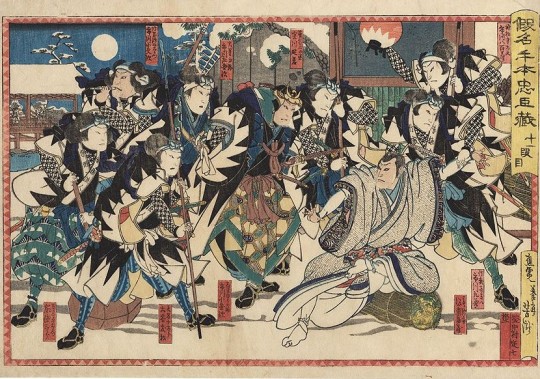
Although this event ended with 47 people being ordered to cut their belly, Oishi Uchizosuke fully demonstrated his loyalty to his lord and his strong faith, which was praised by later generations, and it also brought out the samurai who ignored their own lives in order to maintain their reputation and seek the righteousness of being abandoned. This story was adapted into "The Soul of the 47 Ronin" by Hollywood films in 2013. It is said that Serizawa Kamo was proud of borrowing from the costumes of the Ako clan. Taiga drama "Shinsengumi!" protrayed Kondo Isami as the one interested in Ako's clothing, while Serizawa Kamo’s lover Oume suggested a light blue color to which Serizawa Kamo agreed.

The scene of the Ako Ronin's revenge for their lord is a well-known allusion in Japanese families and one of the three major revenge events in Japanese history. It is often adapted by local or even foreign countries as stage plays, Kabuki, TV series and movies.
As for the asagi color, it is a blue-green color in the traditional Japanese color system, and its name comes from the light-colored green onion leaves. Slicing abdomen is the most noble way of death for samurai, and light blue was the traditional dress color worn by samurai when cutting abdomen. It is said that the light blue color adopted by the Shinsengumi is to remind the team members to swear to death and fight to the death for the most dignified moment.
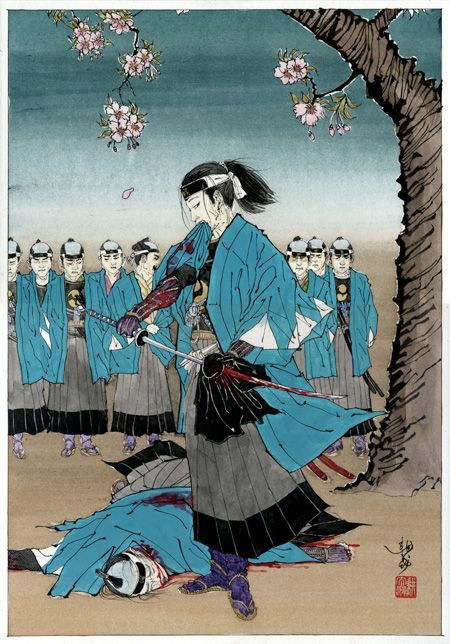
An ancient [modern] painter's depiction of Shinsengumi wearing team uniforms
Part 2
(source: https://shinsengumijapan.com/2020/10/17/asagi-iro/)
In historical records, the haori of Shinsengumi is light blue, but the previous dyes are ultimately different from modern chemical toning. According to Nagakura Shinpachi’s memoirs, the team uniforms of Shinsengumi were arranged by the Daimaru store (Dai-Monjiya) at that time. Daimaru (now Daimaru Matsuzakiya Department Store ) was founded in Fushimi, Kyoto in 1717. In view of this, the Daimaru Kyoto store now reproduces the light blue haori of the Shinsengumi based on the natural dye technology and hand-woven linen materials recorded in the history of the Edo period. Compared with the color of haori produced in general TV and movie productions, the asagi color is slightly darker.
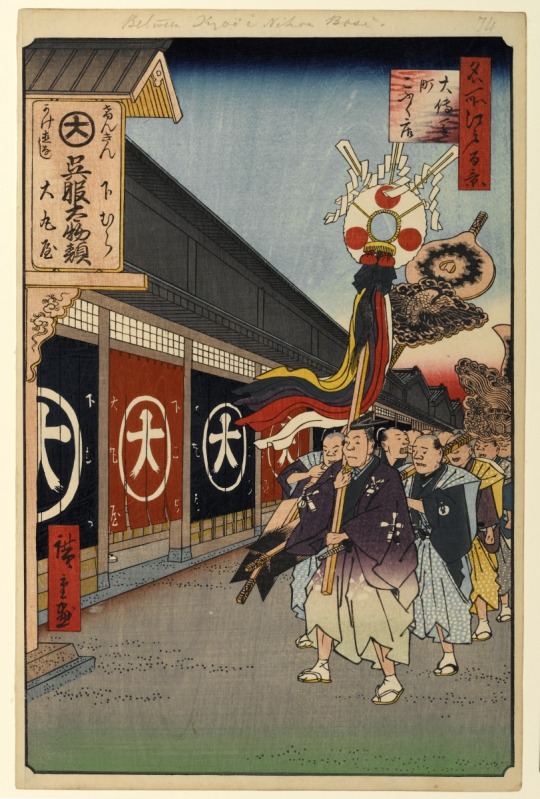
Daimaru Clothes Shop
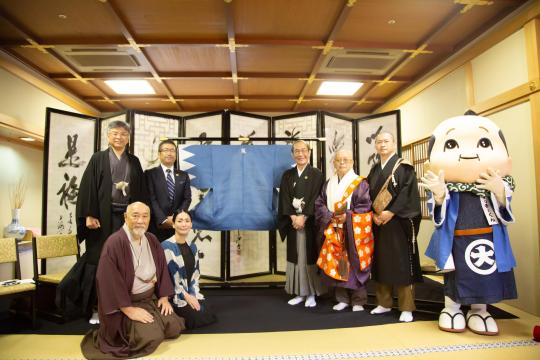

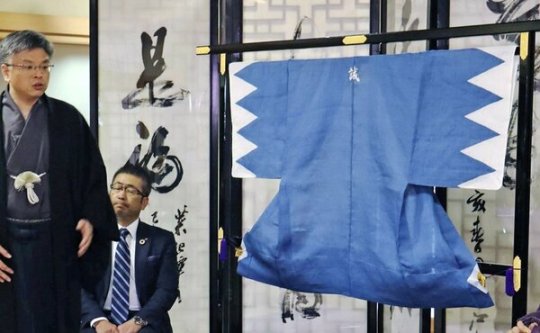
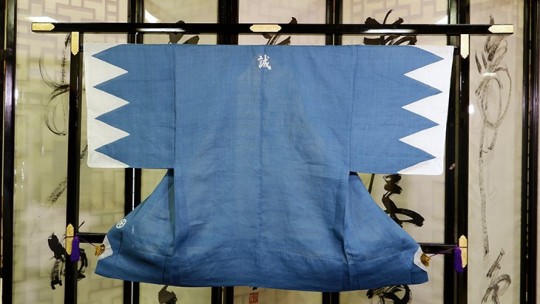
The reproduction of the Shinsengumi haori was exhibited at Mibu Temple in April 2020
In film and television, we always see the Shinsengumi arranged in formation, wearing team uniforms to attend work, very prestigious. But according to Yagi Yusaburo's "Shinsengumi Legacy", the team members were not satisfied with the uniform. I believe that in view of the financial constraints at the time, the team uniforms of the Shinsengumi were made of coarse hemp. It made the upper body too hot and it looked particularly shabby. What's more, in the early Edo period, the light blue color has become a symbol of the lower-ranking samurai outside the city. It is said that when the samurai came to Edo from outside the city, they all chose to wear asagi blue kimono, a color that was a smash hit at the time as in order to blend into this prosperous area. Little did they know, the people in Edo usually use this beautiful color of silk as a the inner part of their kimono, so it’s not exposed to others, so it’s understandable that the Shinsengumi members were somewhat against it. During street patrols, only one or two people at the front put on team uniforms. After the Ikedaya incident, this light-blue set of haori was gradually forgotten, and it can be said that it has only been worn for a year. This is absolutely contrary to the public's perception of the Shinsengumi image.

Haori display
This haori was not very popular among the members, but the "sincere" flag has become a favorite of everyone. Yagi Yusaburo recalled that the team members particularly liked to wave the flags one after another in the open space in front of the Maekawa House. They even made lanterns with the character "sincerity" and mountain-shaped patterns, which were used for stationing and attending work at night. The team members who lived the life of a ronin are now settled down. For them, the identity of Shinsengumi allows them to find a sense of identity in their hearts, and the word "sincerity" makes them dignified as a samurai. The three reasons for choosing the word "sincerity" are less important than this symbolic meaning.
62 notes
·
View notes